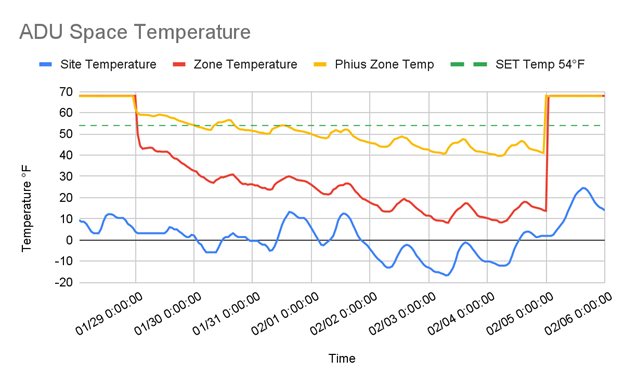In this week’s blog post, Phius Technical Staff member Al Mitchell presents a follow up study on the resilience of accessory dwelling units.
As noted in a previous blog post from last July, the City of Chicago’s building code has recently been changed to allow for the construction of accessory dwelling units – also known as ADUs, coach houses, or granny-flats.
In the previous study, WUFI modeling showed an annual energy savings of 35% by designing one of these small backyard apartments to the 2021 Phius CORE Prescriptive path. The assembly performance values associated with Chicago are noted in the table below.
| Case | Wall R | Roof R | Slab R | Window-U | Airtightness CFM50/sf |
| IECC 2018 | 18.4 | 44.0 | 10.6 | 0.3 | 0.31 |
| 2021 Phius CORE Prescriptive | 40.0 | 71.0 | 21.6 | 0.16 | 0.04 |
As demonstrated by the aftermath of a severe power grid failure in February of 2021 in Texas, buildings need to perform better during inclement weather events and/or power outages. To respond to this need, Phius has put considerable effort into analyzing building resilience and passive survivability. Other institutions have also pushed in this direction. For this first exploration, heating resilience was evaluated.
Those who are familiar with passive building design strategies are aware that these techniques are well suited for reducing the need for space conditioning, especially in cold climates. This comes in handy for heating resilience and survivability.
The super insulation and airtight building envelope retain heat gains in the space, but is it enough when the heat gains are reduced to just the occupants during a power outage? In a cold climate such as Chicago, can this method of building save a life in a severe event? The same single-story coach house from the previous blog post was put through a dynamic modeling study to respond to these questions.
Analysis
First, it is important to establish the metrics for the study.
To quantify the thermal performance during a power outage in the coldest typical week in Chicago, two key metrics were used. The first is a simple graph of the space temperature, where it is easy to see the rate at which heat escapes the building, and whether or not the building temperature stabilizes around a balance point.
The second metric is Standard Effective Temperature (SET) hours. Developed from an ASHRAE research project in 1986, the SET range is based on the Pierce Two-Node comfort model, which is calculated in a similar way to predicted mean vote (PMV). Using this to assess passive survivability, it is quick to evaluate a single number of SET Hours, or degree-hours in which the building zone temperature is outside the SET range, typically from 54°F to 86°F.
The same geometry and assemblies from the ADU study in WUFI were used, and the building was modeled in EnergyPlus, in order to perform accurate hourly calculations. To find a stress case for a power outage, a rolling average was used to find the coldest average week from the hourly TMY3 weather file. For Chicago, MDW Airport, that week is January 29th through February 4th.
In the simulation, the power to all systems other than the ERV was cut out. Based on preliminary work, it was determined that airtight buildings need to have some form of ventilation to keep CO2 concentrations down, and opening a window can let in too much untempered air. Therefore, especially in cold climates, ERVs should be provided on battery backup. The occupants are assumed to stay home 24 hours a day during this time period.
Infiltration was adjusted between the two cases, and for the IECC 2018, this provided enough air exchange to not require a ventilation system to maintain CO2 concentrations. Hourly temperatures were plotted on the below graph, and SET temperatures were collected.

Conclusion
The IECC 2019 case had 2006 SET hours with a maximum duration of 167 hours below the 54°F. The Phius Prescriptive Case had 164 SET hours with a maximum duration of 56 hours.
Looking at the above graph, it is clear that in the code-built building, the zone temperature drops quickly and reaches a minimum temperature below 10°F. In contrast, the Phius building maintains its temperature more, with a minimum interior temperature of 40°F, which visually seems to hit a balance point temperature. The Phius space will ultimately be cold, however significantly warmer than that of the code built building, and more survivable.
This ADU is a pilot study for Phius, as more resilience studies are done. The aim is to provide guidance and simulation protocol to encourage the testing of building resilience, and to determine a way for it to be integrated into Phius certification programs and projects going forward.
